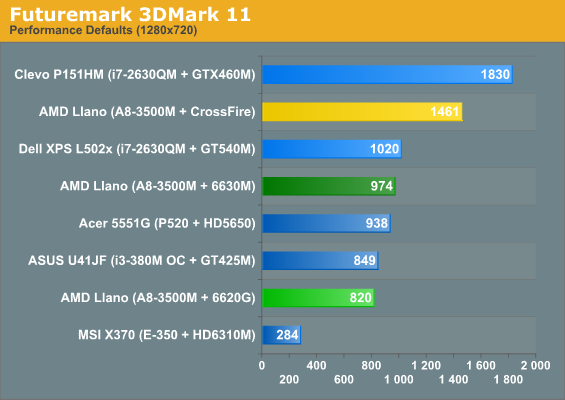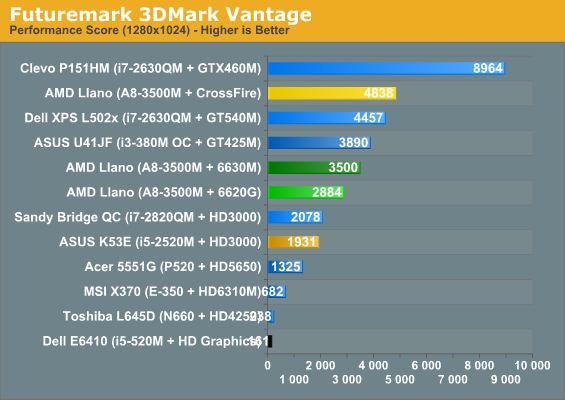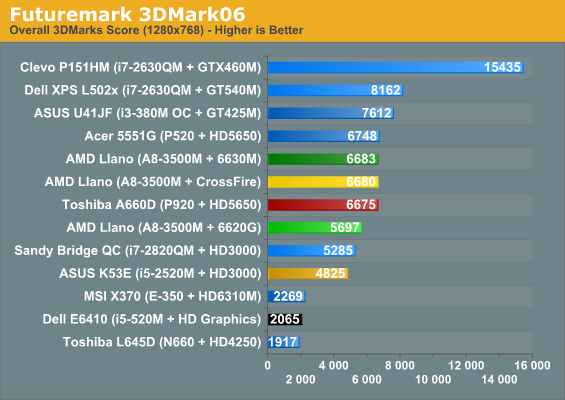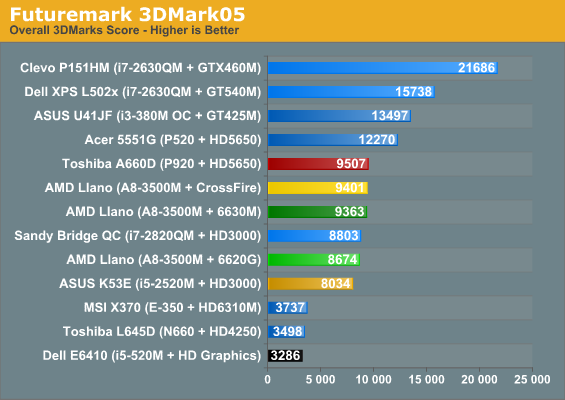The AMD Llano Notebook Review: Competing in the Mobile Market
by Jarred Walton & Anand Lal Shimpi on June 14, 2011 12:01 AM ESTFusion GPUs: A Long-Awaited Upgrade to IGPs Everywhere
During our conversations with AMD, at one point they mentioned that they prefer not to use the term “IGP” anymore since they consider it a derogatory term. I asked what we should call Llano’s graphics and they said AMD officially refers to it as the “Fusion GPU” (fGPU), so that's what we'll use going forward. Regardless of what we call it, though, there’s no doubt that the 6620G fGPU is a dramatic upgrade to the old HD 4250; in fact, the 6620G should also boast significantly better performance than Intel’s HD 3000…provided the CPU core doesn’t become a bottleneck. Let’s start with 3DMark comparisons to see just where Llano falls. Again, we have the 6620G and 6630M Llano setups tested, but now we’re adding CrossFire to the mix.






I’m including all of the 3DMark iterations to provide a broad view of graphics potential. The latest 3DMark11 release seems to be almost purely GPU-limited, but of course it requires DX11 support and thus many of the other laptops (including Intel’s IGP) fail to run it. 3DMark Vantage’s Performance defaults are about as demanding, and Llano comes out 40-50% ahead of Sandy Bridge’s HD 3000. Of course, Arrandale completely falls on its face in the Performance test, generating a result of just 161, but AMD’s old HD 4250 is only marginally better with a score of 238. Remove some of the demands with the Vantage Entry-Level preset and Sandy Bridge starts to close the gap, with the quad-core 2820QM actually coming out ahead of Llano. Things that make you go hmm….
Things don’t get any better when we look at Asymmetrical CrossFire (ACF) from Llano. 3DMark11 comes in a whopping 50% faster than the 6630M dGPU, or 78% faster than the fGPU. If that performance boost showed up in our games, things would be great, but unfortunately it doesn’t. AMD informed us just yesterday that only DX10 or DX11 games and applications will even work with ACF, so perhaps that explains why we see little to no benefit in 3DMark03/05/06. The Vantage Performance preset shows a respectable 38% increase vs. the dGPU and 68% over the fGPU, but on Entry-Level it’s only 11-14% faster, and in 3DMark03 the dGPU actually scored lower than the fGPU.
If we were to stop our analysis of graphics performance right now, I suspect there would be a lot of confusion. Llano’s fGPU is anywhere from being equal to HD 3000 to 50% faster; Asymmetrical CrossFire is either a boon or a bust. So which is it? This is why we only place a minor emphasis on 3DMarks; let’s get to some actual gaming benchmarks.










177 Comments
View All Comments
JarredWalton - Tuesday, June 14, 2011 - link
The only way to make sure that Intel's current processors aren't at the top of most charts is to leave them out, particularly on notebooks. If we only look at IGP/fGPU, AMD comes out on top of graphics charts, but is that fair to NVIDIA's Optimus technology that allows dynamic switching between IGP and dGPU in a fraction of a second? The overall tone of this article (apart from the CrossFire section) is positive, but still people look at the charts and freak out because we didn't manipulate data to make Llano look even better. It's not bad, but it's certainly not without flaws.kevith - Tuesday, June 14, 2011 - link
Oh too bad.I would like to use a laptop for music production with Nuendo and Win 7.
It actually reqires a little more graphics-musclle than you might think to run an app like Nuendo.
And,up to now, it has not been possible to get both a powerful CPU and GPU in the same machine for the money I have.
So now the fGPU is powerful enough, that's great. But it seems, that the CPU-part of these APU's are too weak.
Øv...
krumme - Tuesday, June 14, 2011 - link
ØhhhJust make sure your computer have 1Gb ram and win xp sp2, Nuendo even runs on single core 2Ghz whatever old shit.
I would save the money and buy a e350.
Heck you could even buy an Atom 510, acording to Anandtech, its just as fast as e350 for the cpu side.
When i think about it. Just do that.
ET - Tuesday, June 14, 2011 - link
As madseven7 commented correctly, this isn't the fastest Llano CPU. There are 45W parts which perform better. They will have less battery life, but a significant increase in core speed. If you're interested in Llano you might want to wait until they get reviewed.JarredWalton - Tuesday, June 14, 2011 - link
I suspect the 45W Llano parts will only have less battery life if you're specifically doing CPU/GPU intensive tasks. At idle, SNB and Llano should both bottom out at similar levels. For example, if you have a 2630QM and a 2820QM doing nothing, they both run at a very low clock and voltage. We'll test any other Llano chips we can get and report our findings, but other factors (BIOS and firmware optimizations) will generally be more important than whether the TDP is 35W or 45W, at least for our particular battery life tests.Shadowmaster625 - Tuesday, June 14, 2011 - link
I dont get the Cinebench single threaded results. An N660 is about the same as a desktop X2 250/255 on that benchmark. Yet this A83500M scores only 61% of what an X2 250 does. That would seem to indicate that it is only running at 1.8GHz during that single threaded test. Why so low with 3 idle cores? It should be running at 2.5GHz and scoring 2500, or just neck and neck with a P520. Turbo is clearly not working anywhere near as well as it should be.krumme - Tuesday, June 14, 2011 - link
Well this is AMD business at work. They are in a constant learning process and have been for the last 40 years.Next time they might consider the following:
1. Dont send some half baked prototypes to the reviewers. Wait fx. 3 more weeks. This is just old Jerry Sanders style.
2. Consider not sending stuff to Anandtech. As anandtech lives from backlinking also, the site needs the new product. And AMD, - and for the sake of the consumers right decisions, can live without 3 similar i7 plus high end discrete gfx, at 1.200 usd at the top of each chart. If AMD dont understand they have other interest than Anandtech - its business for all - they cannot serve their own interest. And its about time they start to earn their own money. They are competing against Otellini not some stupid schoolboy.
JarredWalton - Tuesday, June 14, 2011 - link
Thanks, krumme; always a helpful response. Lenovo has taken this to heart, I'm sure you'll be happy to know, and is not sending any review samples our way. Amazingly, we're still able to survive. And FWIW, if AMD hadn't sent us anything, we'd have had more content earlier through other sources. The only way they can get us to abide by NDAs is by actually working with us.krumme - Tuesday, June 14, 2011 - link
Well thank you Jarred. That was an helpfull answer! that explains a lot.I hope AMD gives you attention and work with you in the future, its in all your readers interest.
That means AMD giving you priority, broad access to the right people and more time to do the reviews.
JarredWalton - Tuesday, June 14, 2011 - link
This is something I discussed with AMD numerous times, and it's one of the reasons we want a utility that will show us true CPU clock speeds in real time. Unfortunately, they don't have anything they're willing to share with us right now. They said they have test units where they can monitor this stuff, but it requires special BIOS hooks and those are not present in our preview samples. In theory, Turbo Core should allow the single-threaded Cinebench result to run up to 60% faster than non-Turbo. Of course, we can't even disable Turbo Core either, so we don't know how much TC is actually helping.P920 is clocked 6.7% higher than A8-3500M, but 3500M has twice the L2 cache and some other enhancements. With 3500M coming in 17% faster than P920, that would suggest that 3500M averages around 1900MHz, but that could mean it runs at 2.4GHz for a bit and then 1.5GHz for a bit, or somewhere in between.
Given the way AMD does Turbo Core (monitoring instruction workloads and their relative power requirements), I think that at least right now, it's not being as aggressive as Intel's Turbo Boost. It feels more like Bloomfield and Arrandale turbo, where you got an extra 2-4 bins, rather than Sandy Bridge where you can get an extra 5-10 bins. Hopefully we'll see refinements with Turbo Core over the coming months and years.